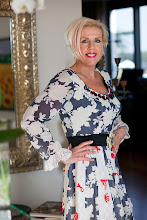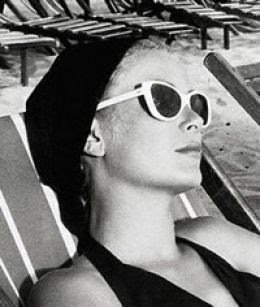
Little did the architects of the Big Biba store in London’s Kensington High Street know they were helping to create a legend. During its brief existence from 1973-75, the opulent emporium was hailed as ‘the most beautiful store in the world’.
Even Mr Al Fayed would have been impressed with the shop’s extravagant Art Deco interior, which was reminiscent of the glamorous, golden age of Hollywood. Big Biba wasn’t just about style – it was the first lifestyle store. Here a young girl could “buy not only a new wardrobe, fully co-ordinated from head to toe, but also a complete range of cosmetics and soft furnishings, together with the washing powder to care for her clothes, and food to go with it, all presented in the distinctive Biba packaging.”
Big Biba wasn’t just about style – it was the first lifestyle store. Here a young girl could “buy not only a new wardrobe, fully co-ordinated from head to toe, but also a complete range of cosmetics and soft furnishings, together with the washing powder to care for her clothes, and food to go with it, all presented in the distinctive Biba packaging.” Alternatively, she could lounge around in the shop-windows (as Biba didn't have window-displays), or sip cocktails upstairs amongst the flamingos that lived in the Roof Garden, or in the Rainbow Room, where live music was performed.
Alternatively, she could lounge around in the shop-windows (as Biba didn't have window-displays), or sip cocktails upstairs amongst the flamingos that lived in the Roof Garden, or in the Rainbow Room, where live music was performed.
'Biba style' was characterised by flowing lines, floppy hats and… pickled onions! For all it’s curiously cool, stylish charm – Biba was peculiarly quirky and eccentric: Even the food hall displays were in the shape of baked bean tins and Campbells soup cans. But it was the Biba logo that was immediately recognizable on the vast majority of the products.
Biba also produced a mail order catalogue, with girls wearing the complete Biba look – from clothing to makeup and accessories. The Biba look consisted of what Hulanicki called "Auntie colours" - which she said ‘look like a funeral.’ The predominant shades were blackish mulberries, blueberries, rusts and plums.












If you’d like to see more of images of the store and Biba’s designs, how about this fabulous, collectable coffee table book from ShopCurious. ‘Welcome to Big Biba’ features over 150 colour photographs from the seven storey department and is signed by designer, Barbara Hulanicki herself, as well as the book’s creators.
In addition to selling stylish fashion, Big Biba was a social network and curiosity shop all rolled into one. I have a feeling the legend will live on and on... I'm curious to experience Biba’s next incarnation – and see the website.
Are you?
Blog Archive
-
▼
2010
(127)
-
▼
April
(10)
- Biba's everlasting appeal
- Time capsule trends
- Grace Kelly style: timeless with a quirky twist
- Preserving fashion forever
- Castaway couture, or wot?
- Blossom springs eternal
- The immortal style of Hardy Amies
- Time and tide...
- Holy Romans, ruins, romance... and rain
- Have a curiously happy and healthy Easter!
-
▼
April
(10)
Twitter Updates
Followers
About Me

- Susan
- Curiously crazy? Curiously creative? Curiously clever? A colourful curiosity? Are you curious?
My Blog List
-
dropshipper2 years ago
-
-
I'm back!9 years ago
-
New Word : ICONATOMY12 years ago
-
Total Pageviews
Links
- BLDG BLOG
- Cabinet of Wonders
- Colin McDowell
- disneyrollergirl
- Elizabeth Avedon
- Fashion Preserve
- fredbutlerstyle
- Godammit, I'm Mad!
- Lenorenevermore
- Luxe et Vanites
- Make Do Style
- Morbid Anatomy
- Nigeness
- Outsapop Trashion
- Pretty Portobello
- Profoundly Superficial
- Race Of Style
- Random Fashion Coolness
- ruminant
- Simply Healing
- Stella's Roar
- Style Bubble
- Style Porn
- The Spectator Arts Blog
- Think of England
- Thought Experiments
Tag Cloud
Style with brains.
Tuesday 27 April 2010
Biba's everlasting appeal
Thursday 22 April 2010
Time capsule trends

‘Too fast to live, too young to die’ - the curiously appropriate final declaration of Malcolm McLaren’s life, daubed punk-style, along the side of his coffin... Seems like death has become the ultimate style statement.
Curious trends aside, we asked members of our group at Are you ShopCurious? on Polyore to create a digital time capsule to commemorate their life, reflecting their individual style, personal achievements, wishes and dreams. We were totally stunned at the response to our contest and the amazing standard of entries. The time capsules include favourite people, places, fashion, art, design objects, films, books, music, curiosities, feelings and the things most special to each creator.
Do you?
Monday 19 April 2010
Grace Kelly style: timeless with a quirky twist

Last May, we featured retro fashion and accessories from the 1950s and ‘60s. I was so surprised when I visited the Grace Kelly: Style Icon exhibition at London’s Victoria and Albert Museum to discover that some of the pieces on offer at ShopCurious are uncannily similar to those worn by the late filmstar and Princess of Monaco.
Take a look for yourself:
One of the exhibits on show is Grace’s classic black dress, designed by Edith Head for Rear Window (see above). Our original 1950s lace version, left, looks almost identical.

She carried her pet poodle Oliver everywhere, so it’s hardly surprising that one of Grace’s signature pieces of jewellery was a poodle brooch, The fine gold one on display in the V and A’s exhibition (left) is every bit as quirky as our charmingly curious vintage costume pooch.

In this photo, Grace wears creamy white framed sunglasses, just like ours.

And our vintage lilac net skirt looks remarkably similar to this dress, designed by Helen Rose for Grace Kelly in the film High Society. The princess loved pastel shades – and now they’re back in fashion once again.

Grace Kelly simply oozed timeless elegance, but her personality and sense of fun were expressed through unique accessories and touches of individual embellishment. I call that style with brains.
Do you?
PS Look out for our Grace Kelly giveaway - coming soon.
Friday 16 April 2010
Preserving fashion forever
![]()
On the eve of the Grace Kelly exhibition at the Victoria and Albert Museum in London, I thought it might be nice to take a look behind the scenes. It’s amazing that so many of the style icon’s clothes and accessories are still in such fabulous condition. A few, including the 1955 Oleg Cassini designed dress shown on the exhibition poster and book cover (see right), are no longer in existence. However, Jenny Lister, the exhibition’s curator, was given a choice from around 300 stunning dresses, largely because Princess Grace’s clothes were so well cared for and looked after at the Palace of Monaco.
In the interests of gleaning some hot tips on how to keep the ShopCurious stock in pristine condition, I was especially curious to know where and how the V and A’s highly prized antique costumes and vintage clothing are preserved for posterity. Rather like a big hotel, department store or hospital, a large part of any museum will never be seen by the general public. If you ever get the opportunity, it’s fascinating to explore the enormous back rooms, where so many of a museum's treasures are housed and maintained.
Getting into the costume stores at the V and A is rather like entering Fort Knox. Apart from the security procedures, there are also strict rules about how one should dress and what can be taken inside the temperature controlled rooms. Opportunities to handle the garments are restricted to key personnel, who must wear latex gloves at all times.
In the past, fashion has been kept at the museum mainly as a record of dress style through the ages. Historically, collecting art and antiques has been a predominantly male pastime - anything to do with vintage clothing was considered somewhat lightweight in comparison. In the 1950s and ‘60s, movie costumes weren’t thought to be that valuable and were often recycled, or purchased by stars, such as Grace Kelly, after filming was over. It’s only in recent decades that items of vintage clothing have become valuable collectors’ items in their own right – and film studios are scrambling to buy back the costumes they created decades ago.
For fashion pieces to be collectable, it’s essential they’re in the best possible, ideally mint, condition. The problem is that most fabrics are perishable and affected by wear and tear over the years – as well as being prone to attack by moths and beetles. For these reasons, all of the V and A fashion department’s items are kept in purpose built fridges, each numbered and marked up with details of their precious contents.
However, some garments, like this 1960s Mondrian inspired PVC dress by Stephen Willats, are probably less appealing to pests than others.
All potential exhibits are catalogued, (some more scientifically than others), for quick and easy retrieval, when necessary. Here you will find everything from Vionnet to Vivienne Westwood:
There are rare Fortuny dresses, beautifully made and embellished clothing and accessories from the likes of Schiaparelli, Dior and Balenciaga, curious retro creations by designers such as Mary Quant and Mr Fish - and extravagant celebrity gowns, like the Elizabethan sleeved, Liberty print Bill Gibb dress worn by Sandie Shaw (see below).




Upon death, most people’s old clothes are taken to charity shops, sold at auction or distributed amongst family members to be worn, or kept as heirlooms for future generations.
It’s great if clothing can be recycled and given new life in this way, but if you want your cherished vintage collection to be well looked after when you die, you might consider leaving it to the Victoria and Albert Museum.
I can’t guarantee you’ll be immortalized like Grace Kelly, but at least you’ll know your clothes will far outlive you.
Will you?
Tuesday 13 April 2010
Castaway couture, or wot?

Entrepreneurs, senior executives and trade bodies representing the luxury goods industry will meet in Barcelona tomorrow for the 12th Annual Prestige Brands Meeting.
Europe has always been considered the main producer and market for premium products, with European brands accounting for around 75% (approx. $229 billion) of the global luxury market, according to figures from the Boston Consulting Group.
However, the Financial Times reports serious concern regarding the erosion of specialist skills such as dressmaking, watchmaking and perfume creation in the European luxury goods sector, combined with a shift in production to emerging markets in Asia and eastern Europe.
Guy Salter, deputy chairman of Walpole, the British Luxury alliance claims that “All young people want to be designers and very few, makers." He says, "We want to try and change that by promoting craftsmanship in the luxury sector" adding, by way of example, "only a handful of small manufacturers in the UK are now making bags and leather accessories, compared to over a hundred factories only fifty years ago."
Some brave souls are already taking their own action to help preserve traditional skills and crafts for posterity, amidst a rapidly changing global marketplace. StyleCurious featured Mark H, a personal victim of UK manufacturing's demise, has made it his mission to turn adversity to advantage in a bid to save British craftsmanship from extinction.
Mark says, “There are still people alive, but only just, who remember England as the Workshop of the World, making everything from corsets to a silver condiment train for the Maharaja of Jaipur.” He adds, “We were busy making things: inventing, tweaking, fumbling, making fools of ourselves – the world’s eccentrics – in garages and small workshops all over this green and pleasant land. To achieve a Royal Warrant to supply members of the British royal family was a licence to export products to every part of the globe.”
In order to help prevent the UK’s industrial heritage from being totally “squandered”, Mark decided to establish his own curiously eccentric new luxury brand called OR WOT! to capitalize on ‘the finest components, skills and crafts that England can muster.”
The story behind OR WOT's ‘Castaway Couture’ collection is highly symbolic. Mark imagined the only survivor from a luxury British cruise ship, marooned on a desert island. Key pieces in the collection are inspired by the survivor's luggage, together with flotsam and jetsam from the shipwreck and the animal and reptile life on the island.
An eclectic range of handcrafted luxuries for him and her, plus a selection of beautifully handmade curious gifts and things for the home by OR WOT! is now available exclusively at ShopCurious.
Each product is made in England, has its own tale to tell and is intended to be a family heirloom that will last for generations to come. What’s more, the skill and craft involved in the making of every single item will be passed on to future generations too.
Curiously crazy, curiously clever, OR WOT?
I'm curious to know what you think.
Do you?






